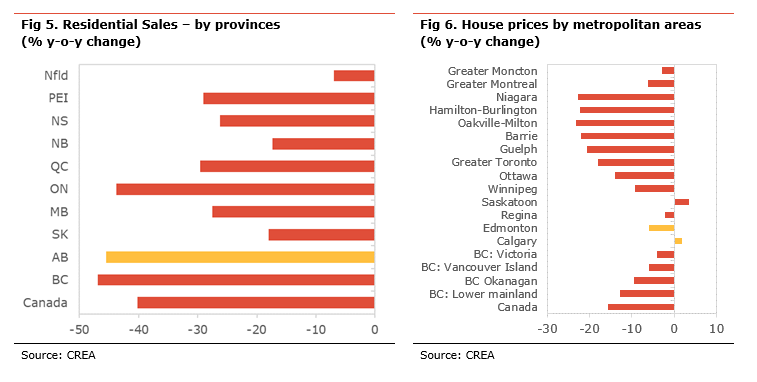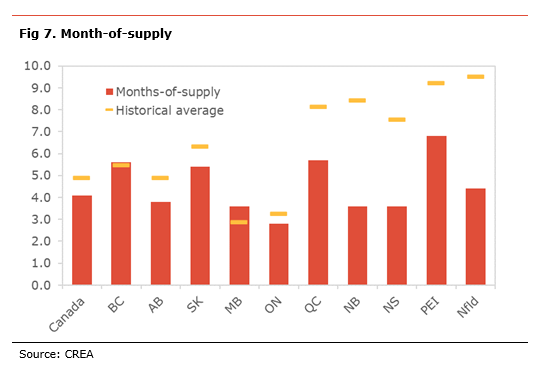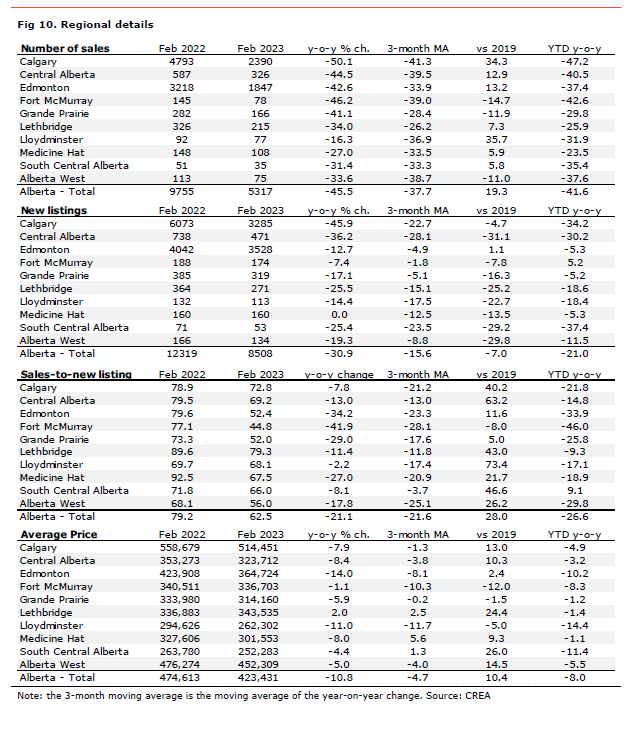Economic commentary provided by Alberta Central Chief Economist Charles St-Arnaud.
Bottom line
National house prices declined for a twelve consecutive month in February, despite an increase in activity. Since the start of the correction, prices nationally have fallen by 15.8%. However, the correction has been more significant in some markets, especially those with the most significant post-pandemic gains. Rising interest rates since the start of 2022 have had a cooling impact on the housing market. Nevertheless, despite the sharp correction over the past year, house prices are still almost 30% higher than on the eve of the pandemic in January 2020.
In Alberta, housing market activity eased slightly in February but remained robust by historical standards. We note a continued divergence between the metropolitan areas. Prices in Calgary have yet to peak and remain the strongest city in Canada, while the price correction continued in Edmonton. With less froth accumulated during the pandemic, Alberta’s market is likely less prone to a sharp correction than other regions, notably Ontario. In addition, strong migration to Alberta will also support activity and prices compared to elsewhere in the country.
Low interest rates have been one of the main drivers of the housing market, supporting affordability. The moderation in activity since the Bank of Canada started to raise rates in March last year points to further weakness this year. As we have shown recently (see), further significant declines in house prices, especially in Toronto, Vancouver, Montreal and Ottawa, will be required to restore affordability. However, the continued lack of supply in many regions and increased immigration could provide some support.
Activity in the Canadian housing market increased by 2.3% m-o-m seasonally-adjusted in February. The number of transactions, at 33.6k, is almost 20% lower than on average in 2019 and 40% lower than for the same month last year. It is important to note that all the year-on-year comparisons are distorted by the sharp boom in activity a year ago and, as a result, we will focus on the changes compared to 2019. Activity was generally higher in most provinces, except for a decrease in Manitoba, Alberta and Nova Scotia. The biggest rise in transactions were in BC, Saskatchewan, Ontario and Quebec. In Alberta, the number of transactions declined (-0.4% m-o-m) in February, but activity was almost 20% higher than in 2019.
There continue to be some divergences between provincial markets. Compared to the average level of 2019, the number of transactions is well above its pre-pandemic level in Saskatchewan (+21%), Alberta (+19%), and Newfoundland (+57%). On the flip side, activity is well below in Quebec (-27%), Ontario (-26%), and BC (-21%).
New listings dropped by 7.9% m-o-m seasonally-adjusted in February. The decline was mainly the result of a drop in listings in Ontario (-15.9% m-o-m). Nevertheless, most provinces saw lower new listings with bigger decreases in PEI (-11.8% m-o-m), BC (-5.7% m-o-m), and Newfoundland (-4.9% m-o-m).
With sales activity stronger than new listings in most regions, the month-of-supply measure[1] inched lower to 4.1 nationally, about 2.4 months higher than its recent low. Based on this measure, most provinces have seen a decline in inventories in February and level are still below their 2019 levels, with the exception of Ontario and PEI. Compared to the lowest level of inventory over the past two years, the month-of-supply has increased the most in PEI (+4.5 months), BC (+3.8 months), Quebec (+3.5 months), and Manitoba (+2.1 months). It has increased the least in Newfoundland (+0.0 months), Saskatchewan (+1.3 months), New Brunswick (+1.6 months), and Alberta (+1.7 months). With a month-of-supply at 3.8, Alberta’s housing market remains much tighter than before the pandemic (7.0 months on average in 2019).
Despite an increase in sales and a moderation in inventories, the MLS House Price Index declined by 1.1% m-o-m, its twelfth consecutive month of decline. Compared to last year, house prices eased nationally by 15.8% y-o-y. Most areas saw a decrease in prices on the month. The biggest monthly declines were in Niagara (-2.9% m-o-m), Barrie (-2.4% m-o-m), Ottawa (-1.8% m-o-m), Greater Toronto (-1.6% m-o-m), and Guelph (-1.4% m-o-m). Prices increased on the month only in Saskatoon (+1.1% m-o-m).
On a y-o-y basis, the most significant declines were in Oakville-Milton (-23.2% y-o-y), Niagara (-22.7% y-o-y), Hamilton-Burlington (-22.4% y-o-y), and Barrie (-22.0% y-o-y). Compared to last year, prices rose only in Saskatoon (+3.4% y-o-y) and Calgary (+1.8% y-o-y.
Compared to their recent peaks, prices have declined by 15.8% nationally. However, prices are still almost 30% higher than they were in January 2022 at the eve of the pandemic. Compared to their recent peak, prices dropped the most in Oakville-Milton (-23.3%), Niagara (-22.7%), Hamilton-Burlington (-22.4%), and Barrie (-22.0%). Prices have corrected the least in Regina (-2.6%), Moncton (-7.2%), Montreal (-7.7%), and Edmonton (-8.5%), while Calgary and Saskatoon are the only cities where prices haven’t peaked yet.
In Alberta, benchmark prices eased 0.1% m-o-m and are up 1.8% y-o-y in Calgary and decreased 0.3% m-o-m and -5.9% y-o-y in Edmonton. There continues to be a divergence between the performance in Edmonton and Calgary, likely resulting from higher inventories in Edmonton.
In Alberta, the housing market remains robust, with the level of transactions still above their pre-pandemic level. However, the number of transactions has eased in all regions compared to last year’s same month. (see table below for details). Compared to the average level of transactions in 2019, activity in the province increased by 19%, led by Lloydminster (+36%), Calgary (34%), Edmonton (+13%), Central Alberta (+13%), and Lethbridge (+7%). Activity is the weakest in Fort McMurray (-15%), Grande Prairie (-12%), and Alberta West (-11%).
New listings declined on the month at the provincial level. Compared to the average level of new listings in 2019, new supply in the province decreased by 7.0% and was lower in most regions, except for Edmonton (+1%). New listings declined the most compared to 2019 in Central Alberta (-31%), Alberta West (-30%), South Central Alberta (-29%), Lethbridge (-25%), and Lloydminster (-23%).
With sales weaker than new listings, many regions have seen an easing of their housing markets. The primary seller’s markets are Lethbridge, Central Alberta, Medicine Hat, and Calgary. The main buyer’s markets are Fort McMurray, Edmonton, Grande Prairie, and Alberta West.
Average house prices declined by 4.7% on a 3-month moving average of year-on-year in the province but was mixed at a regional level. Prices increased the most in Medicine Hat (+5.6%), Lethbridge (+2.5%), South Central Alberta (+1.3%), and Grande Prairie (-0.2%). The biggest house prices declines were in Lloydminster (-11.7%), Fort McMurray (-10.3%), Edmonton (-8.1%), and Alberta West (-4.0%).
[1] The month of supply measures how many months is would take at current sales volume and without an increase in listings to bring inventories to 0.







Independent Opinion
The views and opinions expressed in this publication are solely and independently those of the author and do not necessarily reflect the views and opinions of any organization or person in any way affiliated with the author including, without limitation, any current or past employers of the author. While reasonable effort was taken to ensure the information and analysis in this publication is accurate, it has been prepared solely for general informational purposes. There are no warranties or representations being provided with respect to the accuracy and completeness of the content in this publication. Nothing in this publication should be construed as providing professional advice on the matters discussed. The author does not assume any liability arising from any form of reliance on this publication.